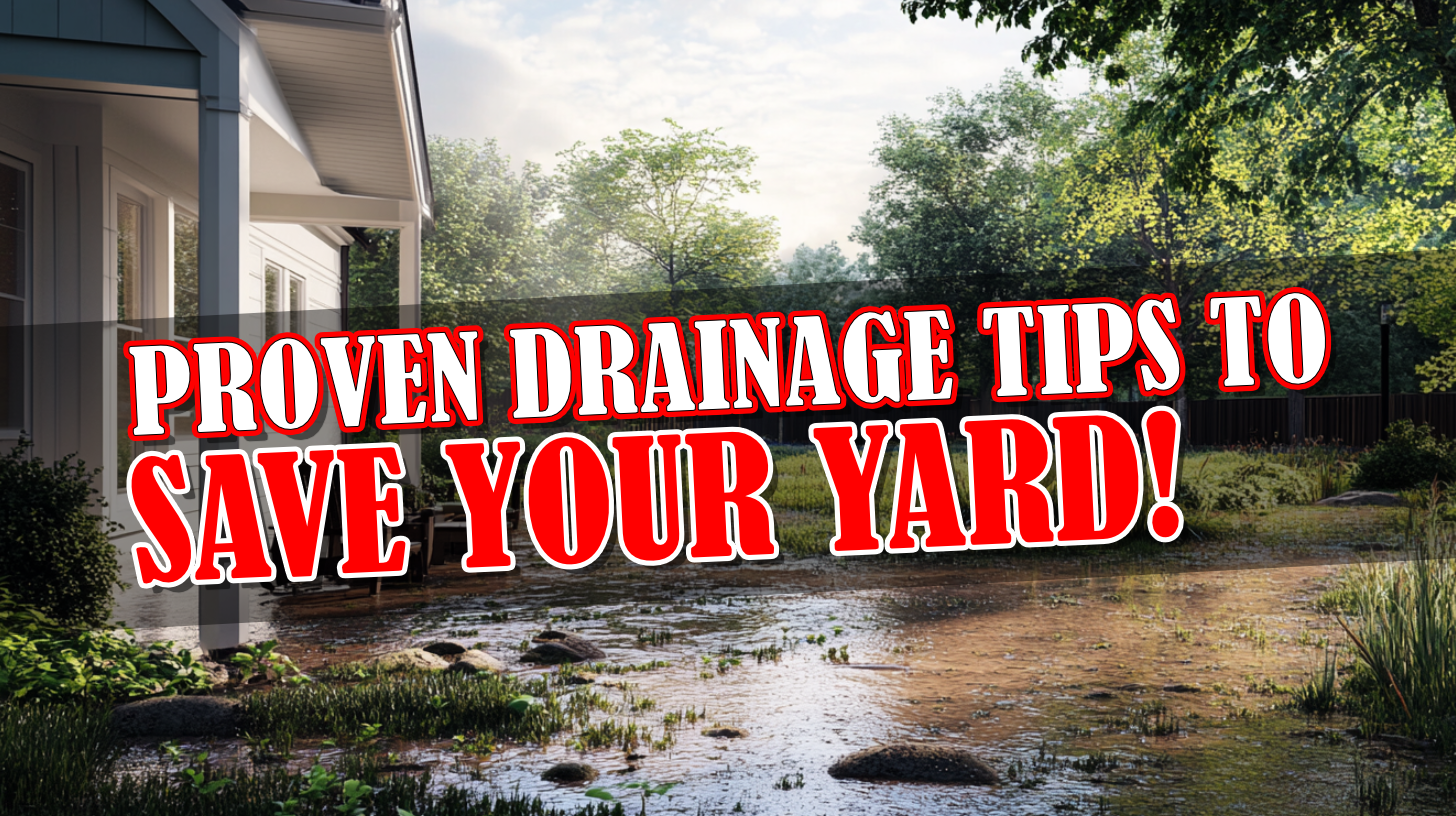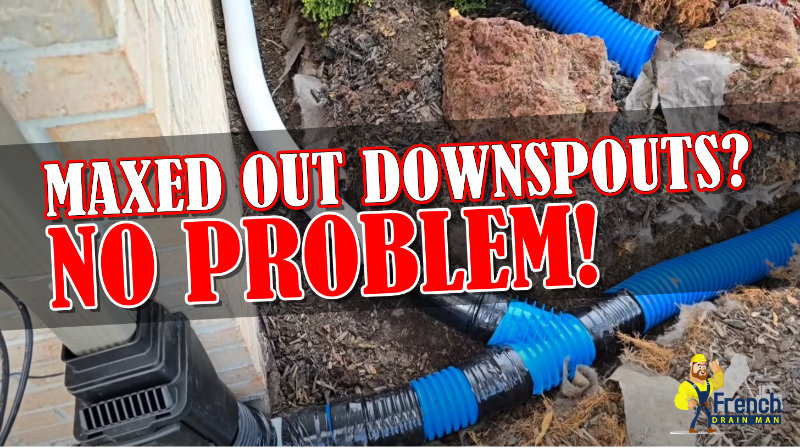Yard Drainage for Yard Flooding in Oakland Twp., Michigan
 Welcome to the French Drain Man channel where the camera is always on the subject matter and not me. I’ve wanted to bring this to you for a couple of years now, but we had to wait for another storm to show you the results. So this was a homeowner whose yard would flood, and this is a walkout basement. So what would happen as you can see how high the water is on their fire pit, on their lawn chairs. And you have the walkout doors right there. When I got there, I shot the water line. The water line was so helpful. All the bark mulch was floating. Grass clippings and bark mulch would leave a line on everything on the glass to the walkout doors, over here on this fire pit. Even going into the pool yard, I was able to see the water line. That way I could shoot the entire backyard and take topols — water seeks level. So I was able to see that flood line on absolutely everything. These pictures were taken from a house, a two-story home that was backed up to this home. The neighbor took these pictures for them. So again, it’s a walkout, so you have the driveway and then you have a staircase down into a backyard. So I pieced these together, these were given to me by the neighbor.
Welcome to the French Drain Man channel where the camera is always on the subject matter and not me. I’ve wanted to bring this to you for a couple of years now, but we had to wait for another storm to show you the results. So this was a homeowner whose yard would flood, and this is a walkout basement. So what would happen as you can see how high the water is on their fire pit, on their lawn chairs. And you have the walkout doors right there. When I got there, I shot the water line. The water line was so helpful. All the bark mulch was floating. Grass clippings and bark mulch would leave a line on everything on the glass to the walkout doors, over here on this fire pit. Even going into the pool yard, I was able to see the water line. That way I could shoot the entire backyard and take topols — water seeks level. So I was able to see that flood line on absolutely everything. These pictures were taken from a house, a two-story home that was backed up to this home. The neighbor took these pictures for them. So again, it’s a walkout, so you have the driveway and then you have a staircase down into a backyard. So I pieced these together, these were given to me by the neighbor.
Now the homeowner contacted the DPW and the Building Department. When that didn’t get them anywhere because they said the storm drains were clean and clear of debris, then they went to Oakland County Water and Sewer. This is an Oakland Township. In the end, they were left with having to take care of this problem on their dime.
When the home was built and it was approved, it was pretty nip-and-tuck for a walkout and there wasn’t a whole lot of room. The yard was really flat. So the storm drain system ended up during really, really hard rains becoming overwhelmed. This didn’t happen right away. This is a combination of things. I’m going to show you a shot from underneath that deck. So here’s a shot underneath the deck and you can see the fire pit. I was able to get a waterline off that fire pit. That was very helpful. But you can see the pool. Brand new pool, fence isn’t even in yet. That was the straw that broke the camel’s back. Because a lot of this water, when the storm drains would end up overwhelmed, the neighbor would take some of this water. They would end up displacing. We’d have a lot of water displaced over three times the area basically. And once this pool was built in this backyard and they raised the elevation of the backyard, none of the water was displaced in the neighbor’s yard anymore. So it compounded the problem. It was always a problem. But this is again, the straw that broke the camel’s back. This is when they ended up with 10″ of water in their basement.
So imagine that a big storm is coming through, the neighbor put in a pool next door and changed the way the water is displaced until the storm drink and get caught up. So this doesn’t happen every rain. This happens on those big rains. Those one or two rains you get a year. The red cell rains, 2″-3″ real fast. Just a flash flood. That’s when this happens.
Every contractor that came out to see these photos with their measuring wheel and they’re measuring tape, looked at the homeowner and said, what do you want me to do? And they were looking for suggestions. They were looking for somebody that knew what to do and nobody ever got back to them. Luckily for the homeowner and me, this was a good fit for us. Really good fit. This was a fun job, I really enjoyed it. The homeowners were great, loved them. Wonderful to work for. But basically this is what we ended up doing.
So that pool yard you seen, we had to take the fence down and we had to take the little narrow path and a couple steps out. We built some nice, big waterfall steps. You can see that pool that I talked about. We brick paved up into the pool yard too. So they took this opportunity to go ahead and make they’re outdoor living space a lot nicer.
I’m going to show you a few more pictures. This is three events that I’m going to end up showing you here. You got the initial big rain, all the floodwater. You have pictures of what we did. Then we have the pictures of a flood after. So that’s why it took me some time. This is two years in the making. The installation itself we did in about three weeks. Again I really enjoyed this. The crew enjoyed this. They take a lot of pride in what they do and we had a lot of fun.
There’s that pool when it was under construction. I want to make mention, I was talking about how I shoot the waterline. On this last step that came into the backyard. I was able to shoot a waterline that was, that was a crucial topol for me. We built the backyard up and we retained it with this block wall. And then we went to natural stone to match the natural staircase. And I knew the waterline on this step right here. So that was money. Having those numbers are great. Pictures are so valuable. So if you find yourself in a situation like this, take pictures. Take pictures from as many different angles as you can. It’s really helpful.
So now I’m going to show you the flood before the work was done. There’s that pool yard. Here’s a good reference. You have your daisies and they ended up in that shot. Here is after the whole backyard was raised and I did use clay. Now, this was shot from inside the house that we worked for looking out during a hard rain. You couldn’t step out and get pictures. It was a quite a storm. But we’re so much higher now. Right here is where the storm drain catch basin is. Here’s my dry creek bed, where I’m pumping all this water to. Now the water has to be displaced throughout the swale, down several backyards. It’s not hurting anybody, and most importantly, it’s not flooding anybody out.
The building department along with Oakland County water and sewer, told the homeowner to fix it with landscape treatment. I love working in Oakland Township for that reason. They handle things differently and they see a lot of value and in what we can do. It’s tough when something like this happens. The infrastructure can’t handle the flood water. The house was just marginally made a walkout, probably shouldn’t have been a walkout. This backyard was flat. It was always wet, even under a light rain because it was so flat and it couldn’t really drain. So the homeowners really enjoyed this project. Here’s another storm shot of that same location. Just heavy, heavy rain. You can see it’s coming down like cats and dogs in these pictures. You see all the water in the picture.
So we brought in clay when we did this job. We went ahead and backfield this retaining wall with clay. Why is that? A sand vein, a gravel vein water will just run right through that vein of sand or gravel, pour through the blocks. And we don’t want that. I wanted something that was going to act almost as like a rubber liner. We can grow bluegrass in Michigan on clay. We’re actually quite used to it because we have more clay lots than we do sand or anything else. There’s that pool again in the neighbor’s yard and it’s finished.
I had to go back and it’s January because we’re so busy during the season, I couldn’t get finished pictures. They do such a nice job with their Mediterranean pots. They can have this beautiful vibe, really nice feel to their pool yard. I wish I had some great summer shots just to show you how beautiful this place turned out.
There’s that dry creek bed in here. Here are the electrical plugs. So the pump is in the corner here. We’ve got a five-foot lift station and we ran the electric underneath the wall. We got the pump plugged in. We’ve got a raceway in case we ever have to change it out. And then we are pumping the water right here at the top of the dry creek bed. It runs down the storm drain catch basin and it works really, really well.
This here is all an open French drain. I know people are gonna have questions. How do you get the water out of there? You know it’s simple. Everything’s sloped. And we have a couple of pipes and this is all stone. Nothing drains better than an open French drain. So the water just runs right through the stone. And we didn’t even fool around with this. I mean I have 1 1/2″ cobble, so I got big voids in the stone. Really, really big voids in the stone. So there’s pipe below the stone and then in this corner here is a lift station. It’s 5 ft. deep, it will never freeze because it’s five feet deep and it’s 24 inches in diameter. So it’s gonna keep up with all the water that’s rushing in during the storm, which is nice.
So again, this is a job that I’ve been wanting to, to show you, but it took, you know, we had to wait another year to get some good storm pictures for the homeowner, be home, get me some pictures, but imagine, you know, finding yourself in this situation, you know, the homeowner put it best. You feel so helpless. You know, you call a building department, they don’t have an answer for you. They tell you to fix it with landscape treatment, and you need to call the Public Works and they, they go through the pipes, they go through the storm drain and there’s no debris blocking it. Everything’s working the way it’s supposed to and you know, they’re just shrugging their shoulders saying, don’t know what to tell Ya. Um, you can see these two poles here, the fire pit got these two poles here and that’s where the fire pit was just to give you an idea of what it was that we did to correct for this problem.
So this is something we do on a regular basis. Something we enjoy doing. I’m bringing the drain crew with the brick crew and um, and you know, just have a lot of fun and create something beautiful. Here. The homeowner was wondering, you know if people think they have to move, you know, and when something like this happens. They believe the only way out is to have to move and people actually do, which is a shame. But no, you don’t have to move. Just give us a call at 248-505-3065.
This is an Oakland Township and the building apartments. Wonderful. I love working with them. Um, no problems in Oakland Township. They, they really, they really let us. And you know, we keep everything to code. Our rises on our steps or code, you know, are treads is to code. So that’s what’s great about having a licensed builder that has both a landscape company and a drainage company. We’re not your average yard drainage company, that’s for sure, or your average landscape company.
So we’re a one-two punch. We can do the jobs, the others can’t. And if you liked the material that I’m bringing you, I’m trying to show you jobs that are, you know, people started asking for something. Um, well we started out to shooting videos, very generic jobs and people just wanted more. I’m showing you more, I’m showing you more and if you’re liking what I’m showing and different techniques and I’m sharing with you the things that we’ve come up with over 30 years, I mean please, you know, hit the like button, it supports that channel that keeps us going. And, um, and if you’re not a subscriber already subscribed, we’re going to continue to bring you new, fresh information, a new fresh look on how to handle severe water problems. Uh, you know, even just light water problems, uh, you know, we take care of it all and um, we’re going to continue to, uh, to reveal more of what it is we do.
So again, I want to thank you for supporting the French Drain Man YouTube channel if you’re a subscriber and if you’re hitting the like button and as always we’re going to keep bringing in new content and we’re always going to keep the camera on the subject matter and not me. All right guys, thanks again.








